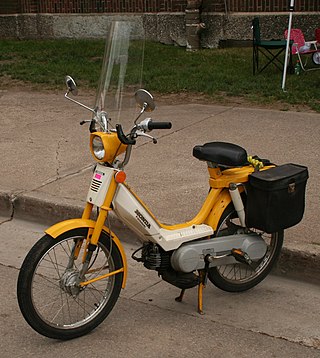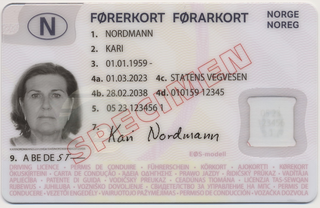
A motorcycle is a two or three-wheeled motor vehicle steered by a handlebar from a saddle-style seat.

A moped is a type of small motorcycle, generally having a less stringent licensing requirement than full motorcycles or automobiles. Historically, the term exclusively meant a similar vehicle with both bicycle pedals and a motorcycle engine. Mopeds typically travel only slightly faster than bicycles on public roads.

An L-plate is a square plate bearing a sans-serif letter L, for learner, which must be affixed to the front and/or back of a vehicle in many countries if its driver is a learner under instruction, or a motorcycle rider with provisional entitlement to ride restricted motorcycles.

The Driving Standards Agency (DSA) was an executive agency of the UK Department for Transport (DfT).
Graduated driver licensing systems (GDLS) are designed to provide new drivers of motor vehicles with driving experience and skills gradually over time in low-risk environments. There are typically three steps or stages through which new drivers pass. They begin by acquiring a learner's permit, progress to a restricted, probationary or provisional license, followed by receipt of a full driver's license. Graduated drivers' licensing generally restricts nighttime, expressway, and unsupervised driving during initial stages, but lifts these restrictions with time and further testing of the individual, eventually concluding with the individual attaining a full driver's license.

A motorized bicycle is a bicycle with an attached motor or engine and transmission used either to power the vehicle unassisted, or to assist with pedalling. Since it sometimes retains both pedals and a discrete connected drive for rider-powered propulsion, the motorized bicycle is in technical terms a true bicycle, albeit a power-assisted one. Typically they are incapable of speeds above 52 km/h (32 mph), however in recent years larger motors have been built, allowing bikes to reach speeds of upwards of 72 km/h.
A driver's permit, learner's permit, learner's license or provisional license is a restricted license that is given to a person who is learning to drive, but has not yet satisfied the prerequisite to obtain a driver's license. Having a learner's permit for a certain length of time is usually one of the requirements for applying for a full driver's license. To get a learner's permit, one must typically pass a written permit test, take a basic competency test in the vehicle, or both.

Motorcycling is the act of riding a motorcycle. For some people, motorcycling may be the only affordable form of individual motorized transportation, and small-displacement motorcycles are the most common motor vehicle in the most populous countries, including India, China and Indonesia.
In the United Kingdom, driving examiners are civil servants employed by the Driver and Vehicle Standards Agency (DVSA) in Great Britain and by the Driver and Vehicle Agency (DVA) in Northern Ireland for the purpose of conducting the practical element of driving tests.
The United Kingdom driving test is a test of competence that UK residents take in order to obtain a full Great Britain or Northern Ireland (car) driving licence or to add additional full entitlements to an existing one. Tests vary depending on the class of vehicle to be driven. In Great Britain it is administered by the Driver and Vehicle Standards Agency (DVSA) and in Northern Ireland by the Driver & Vehicle Agency (DVA).
In Canada, driver's licences are issued by the government of the province or territory in which the driver is residing. Thus, specific regulations relating to driver's licences vary province to province, though overall they are quite similar. All provinces have provisions allowing non-residents to use licences issued by other provinces and territories, out-of-country licences, and International Driving Permits. Many provinces also allow non-residents to use regular licences issued by other nations and countries. Canadian driver's licences are also valid in many other countries due to various international agreements and treaties.
In India, a driving licence is an official document that authorises its holder to operate various types of motor vehicles on highways and some other roads to which the public has access. In various Indian states, they are administered by the Regional Transport Authorities/Offices (RTA/RTO). A driving licence is required in India by any person driving a vehicle on any highway or other road defined in the Motor Vehicles Act, 1988. This act sets limits on the minimum age for vehicle operation ranging from 16 to 20, depending on specific circumstances. A modern photo of the driving licence can also serve many of the purposes of an identity card in non-driving contexts, such as proof of identity or age.
The New Zealand driver licence system is a graduated system that has been in place since 1988. It consists of three phases for a car licence, each with varying levels of conditions.

Norwegian driving licences adhere to a standard set in the European Economic Area.

Swedish driving licences adhere to a standard set in the European Economic Area. 18 years is the minimum age to obtain a licence for cars.

In the United Kingdom, a driving licence is the official document which authorises its holder to operate motor vehicles on highways and other public roads. It is administered in England, Scotland and Wales by the Driver and Vehicle Licensing Agency (DVLA) and in Northern Ireland by the Driver & Vehicle Agency (DVA). A driving licence is required in England, Scotland, and Wales for any person driving a vehicle on any highway or other "road", as defined in s.192 Road Traffic Act 1988, irrespective of the ownership of the land over which the road passes. Similar requirements apply in Northern Ireland under the Road Traffic Order 1981.
The legal definition of a motorcycle for the purposes of registration, taxation and rider licensing in most countries is a powered two-wheel motor vehicle. Most countries distinguish between mopeds up to 49 cc and the more powerful, larger, vehicles known as motorcycles. Many jurisdictions include some forms of three-wheelers as motorcycles.

Driving licences in Hong Kong are issued by the Transport Department. A full driving licence is valid for 10 years and is compulsory in order to drive a motor vehicle. Most driving licences are issued after the applicant passed a driving test for the respective type of vehicles. They may be issued without a test if the applicant is a holder of an overseas driving licence issued on passing a driving test in an approved country.
The UK practical motorcycle tests consist of a practical test of two modules. To first ride on the road, a candidate must complete Compulsory Basic Training, however, there is no test.

A driver's license, driving licence, or driving permit is a legal authorization, or the official document confirming such an authorization, for a specific individual to operate one or more types of motorized vehicles—such as motorcycles, cars, trucks, or buses—on a public road. Such licenses are often plastic and the size of a credit card.











